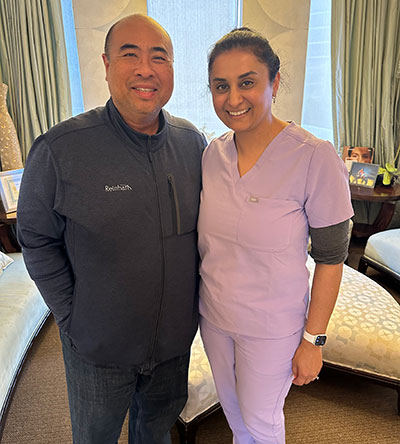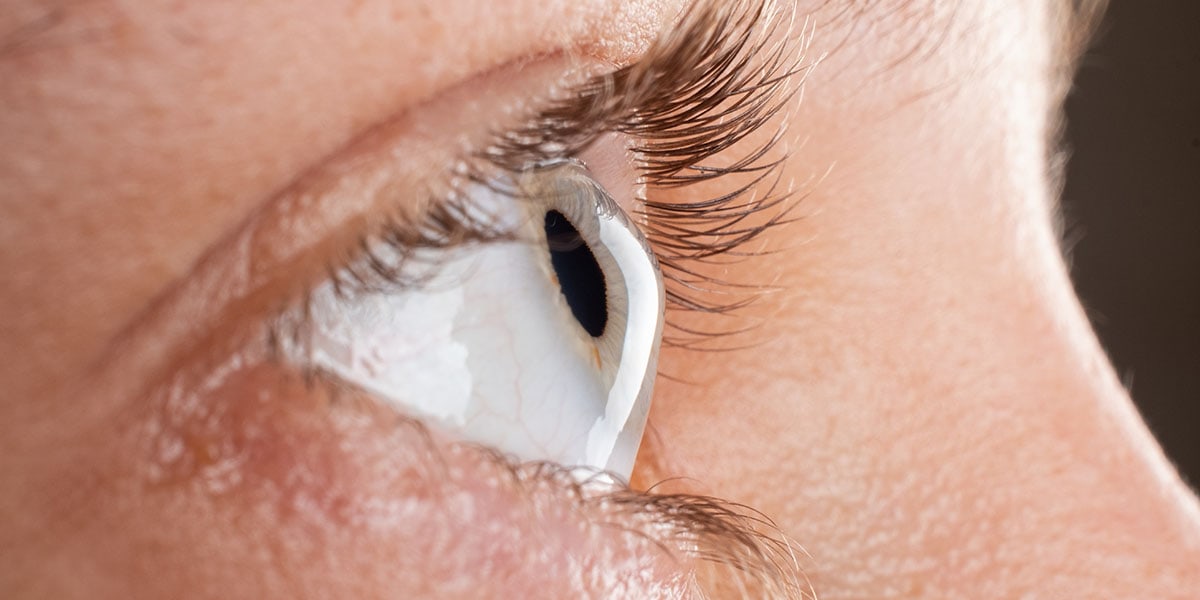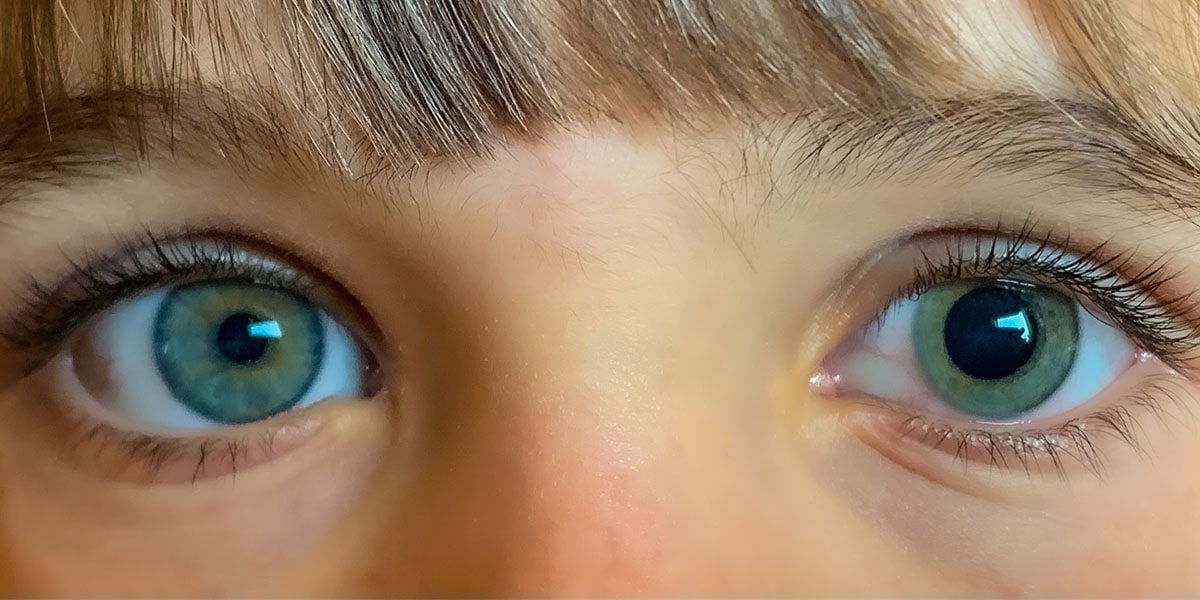- Home
- Patient Stories from Assil Gaur Eye Institute
- Steven Can Finally See His Own Reflection After RLE
Steven Can Finally See His Own Reflection After RLE

Can you imagine seeing your face clearly in the mirror for the first time in years at age 50? It seems farfetched, but that happened to Steve Huang the day after his refractive lens exchange surgery with Dr. Avneet K. Sodhi Gaur.
Those circumstances could only occur if you had spent most of your life as blind as a bat. Steve had been wearing some form of vision correction since second grade. When he was wearing contacts he was fine, but when he switched to eyeglasses about six years ago, he could no longer see his face clearly in the mirror whenever he removed his eyeglasses to wash his face.
But after his refractive lens exchange (RLE), he could see the mirror just fine while applying soapy water to his face.
“It was like meeting a new person,” says Steve, an attorney and the General Counsel at a manufacturing company. “Life just keeps getting better and better.”
- "Take Me Out to the Ballgame" as Steve Can Now See Thanks to the Odyssey Lens!
- EagleVision® LASIK Gives Optometrist Crystal-Clear Active Life
- After Waiting 50 Years, Larry Gets Perfect Vision
- Ally Sheds Her Glasses After State-of-the-Art Odyssey Lens Replacement
- Light Adjustable Lens Gives Ellen Visual Clarity
- Light-Adjustable Lens Heals Jacqueline’s Cloudy Sight
- Actress Tiffany Smith Says Goodbye to Nearsightedness with LASIK
- Aram, a Civil Engineer is Back on Track with New Odyssey Cataract IOL Lens
- Cutting-edge Odyssey IOL lens lets Greta, a busy optometrist, toss her glasses aside
- EagleVision® LASIK Prepares Snowboarder for Olympics
- Eye Freckle Removal Surgery Worth a Cross-Continent Trip
- Sylvia says ‘lazy eye and cloudy vision be gone’ with Odyssey IOL replacement!
- Emily’s Urgent Retina Care Saves Her Eyesight
- Aaron travels from China for the ‘Magic of EagleVision' LASIK
- Nancy is glowing about her new PanOptix® IOL
- Perri, 39-year-old Cataract Patient, Finds Clear Vision 500 Miles from Home
- Dr. Richardson says AGEI stands at the top of eye surgery specialists
- Super lawyer Marc Katz enjoys life without glasses after enVista lens exchange
- Dan loves being glasses-free after Refractive Lens Exchange
- Merry Resolves Severe Ocular Complications with Perfect Monofocal IOL
- Steven Can Finally See His Own Reflection After RLE
- Janet, a Texas Teacher, Travels to Beverly Hills for Eye Freckle Removal
- It’s A Wonderful Life for Mike with 20/20 Vision and New Odyssey IOLs
- Kevin Says Eye Freckle Removal Surgery Was Well Worth the Wait
- Stacy Finds Second Eye Surgery’s the Charm thanks to AGEI
- Lucy’s Trip from Australia to Beverly Hills for Conjunctival Nevi Removal: A Worthwhile Journey
- With Her Cataracts Gone, Young Sara Sees like a Hawk!
- Adrenaline Junkie Finally Rides Safely Thanks to Odyssey IOL
- Julie After Her EagleVision LASIK Procedure
What is refractive lens exchange?
Refractive lens exchange (RLE) is a surgical procedure similar to cataract surgery, where the eye's natural lens is removed and replaced with an artificial intraocular lens (IOL).
Also known as clear lens extraction, this procedure is used to correct vision problems such as nearsightedness, farsightedness, astigmatism, presbyopia (age-related farsightedness), and other refractive errors.
RLE is typically recommended for individuals who are not good candidates for laser eye surgeries like LASIK or for those over 40 who want to reduce their dependence on glasses or contact lenses. By replacing the natural lens with an IOL, RLE helps improve vision and can reduce or eliminate the need for corrective eyewear.
Living with terrible eyesight
About the time he turned eight, it was discovered that Steve’s vision was terrible. The glasses saga began with heavy-duty framed lenses. The inconvenience of wearing glasses with ultra-magnification caused Steve to try lighter contact lenses after about five years.
Contact lenses worked for a while — until he developed an allergy to them. His prescription was also so high that optometrists had trouble correcting his vision. At that point, his only option was to wear glasses. The problem was that the glasses were quite thick because of his high prescription, causing the frames to constantly slip down his nose. The high prescription was also incredibly sensitive, and his ability to clearly see would be thrown off whenever his nose pads shifted.
“I had to leave work to adjust them, and that’s a big thing for me,” he says, referring to racing across town in mid-day traffic. “I finally said enough is enough.”
Steps toward refractive lens exchange
During Steve’s initial consultation with Dr. Gaur for vision correction surgery, she noticed mild glaucoma in his right eye. If left untreated, the eye disease could progress and cause irreversible optic nerve damage and in severe cases can lead to complete vision loss. Dr. Gaur observed Steve’s right eye for a year to make sure the glaucoma did not get any worse and was stable on glaucoma eye drops.
“Once I determined his glaucoma was stable during his refractive lens exchange I also performed a microinvasive glaucoma surgery called canaloplasty to lower the eye pressure and get him off glaucoma eye drops,” she explains. “By eliminating glaucoma medications with the help of this procedure, this reduces the incidence of dry eyes from glaucoma drops which can sometimes decrease quality of vision.”
Steve says he was pretty nervous prior to the surgery. He told himself that a lot of people who were good candidates had already undergone this outpatient surgery, and he needed to be tougher than them.
He confided in Dr. Gaur about his nerves before the surgery. “She said, ‘Don’t worry, I got this’.” Steve said to himself that, "It's gonna be okay," referring to the eye doctor’s can-do approach to the artificial intraocular lens replacement surgery. “Dr. Gaur really calmed me down.”
Selecting the correct lens for Steve’s eyes
Dr. Gaur and Steve discussed the eye surgery's goal of correcting vision and the several options available. After going over his options, Steve and Dr. Gaur decided on placing a new lens in both of Steve's eyes.
He would need to wear reading glasses occasionally for reading up close; however, for distance and computer work, he would be less dependent on glasses for clear vision.
“We chose an Eyhance Toric IOL,” says Dr. Gaur, who was somewhat limited with her lens selection because of Steve’s mild glaucoma and high nearsightedness. “He had a RLE surgery to improve his vision and quality of life. He did absolutely amazing and I’m so excited for him to experience the world with a new perspective.”
Designed with meticulous attention to detail, the Eyhance toric multifocal lenses have an extended depth of focus correcting intermediate and distance vision and, in turn, diminishing visual side effects such as halos, glares, and starbursts.
While sitting in a chair after the surgical procedure, Steve looked across the room and noticed that he could see for the first time without his glasses without any recovery time! After that follow-up, the miracles kept coming.
“My right eye cleared that night, then the left the next morning,” he remembers. “At that point, it felt like the heavens parted, and I could see everything clearly.”
In addition to the life-changing visual clarity, Steve discovered that all these years, he had been slightly color-blind. His lunch bag was dark blue, not black, and his gym shoes had a blue tint. On the domestic front, Steve’s wife had long complained that he failed to rinse the tub after his shower. Lo and behold, after his refractive surgery, Steve got the tub spotless after using it. Needless to say, Steve’s wife loves his better vision!
To say that Steve is grateful to the AGEI surgical staff would be an understatement. “I never knew white was so white. I only knew my version of the color,” he says. “You guys are like magicians.”
Why trust Assil Gaur Eye Institute with your refractive vision correction?
Dr. Kerry Assil and Dr. Gaur have gained industry-wide respect for their extensive knowledge and contributions to cataract and lens exchange procedures. Their knowledge of Intraocular lenses for cataract surgery and Refractive Lens Exchange is unparalleled. AGEI eye center has assembled a team of top ophthalmologists from around the country who offer their patients the highest quality of specialist eye care in the United States.
With over 40 years of combined experience assisting patients with eye health, Drs. Assil and Gaur are among the most experienced eye surgeons in the United States. Dr. Assil has performed over 70,000 eye surgeries and authored over 100 textbook chapters and articles on RLE surgery and cataract surgery.
In addition to refractive lens exchange and cataract surgery, the ophthalmology experts at AGEI are nationally recognized for their eye care and treatment options for a full range of conditions, including eye conditions such as hyperopia glaucoma, macular degeneration, retinal detachment (and other diseases of the retina), cornea conditions, contact lens, floaters and flashes, dry eye, presbyopia, astigmatism, farsightedness, myopia, nearsightedness, and other vision correction procedures (refractive surgery) such as LASIK surgery, PRK.
Please call (866) 945-2745 or make an appointment online.
We are conveniently located for patients throughout Southern California and the Los Angeles area in or near Beverly Hills, Santa Monica, West Los Angeles, West Hollywood, Culver City, Hollywood, Venice, Marina del Rey, Malibu, Manhattan Beach, and Downtown Los Angeles.














